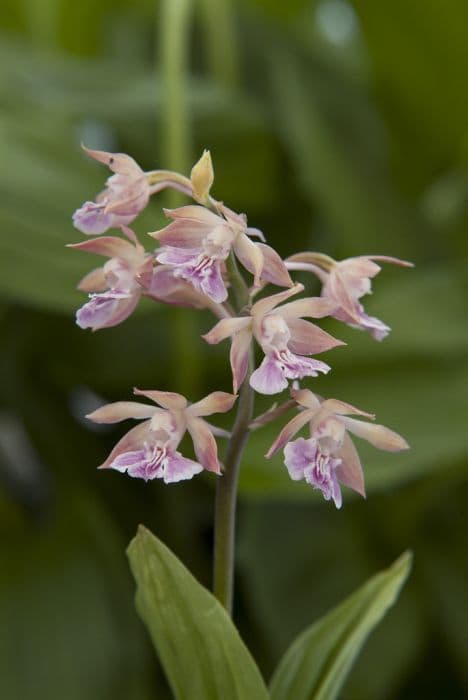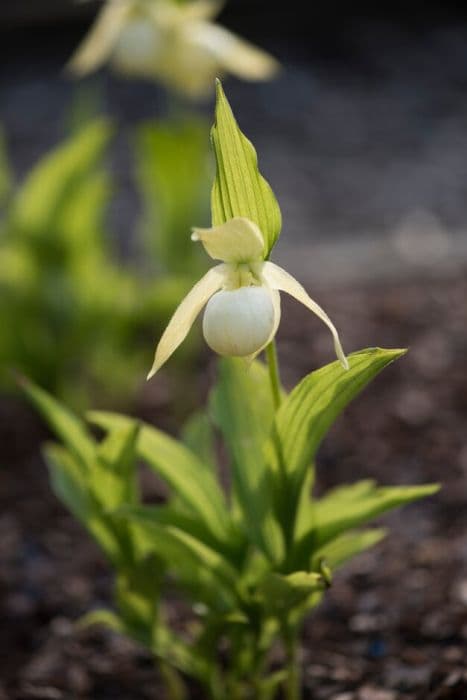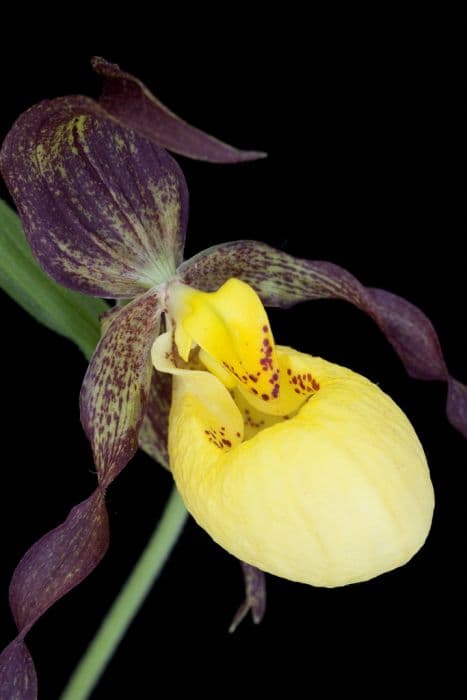Spider Orchid Brassia Eternal Wind gx

ABOUT
The Brassia Eternal Wind gx, often referred to as the Spider Orchid, is a captivating and elegant orchid variety renowned for its distinctive floral display. The Spider Orchid's blossoms are known for their long, slender petals and sepals that extend outward, resembling the legs of a spider, which is how the plant gets its common name. These structures usually feature a graceful, spindly form and can come in a variety of shades, often with a mix of colors such as green, brown, and yellow, frequently marked with an appealing pattern of mottles or spots. The lip of the flower, which is the part that stands out the most, is typically large and broad, serving as a landing platform for pollinators. In terms of its foliage, the Spider Orchid has long, strappy leaves that are a bright, glossy green, adding to the plant's overall lush appearance. They emerge from pseudobulbs at the base of the plant, which serve as storage organs for nutrients and water. The Spider Orchid typically blooms with multiple flowers on an arching inflorescence that gracefully showcases its exotic flowers, providing a display that's both dramatic and visually appealing.
About this plant
 Names
NamesSynonyms
Spider Orchid, Brassia Orchid
Common names
Brassia Eternal Wind gx.
 Toxicity
ToxicityTo humans
The Brassia Eternal Wind, also known as Spider Orchid, is not considered toxic to humans. Generally, orchids are safe and do not cause poisoning when touched or ingested. However, individual sensitivity can vary, and some people might experience mild irritation in rare cases. There are no severe symptoms of poisoning associated with this plant, as it is not known to contain any toxic substances that pose a risk to human health.
To pets
The Brassia Eternal Wind, commonly known as the Spider Orchid, is not recognized as toxic to pets. Orchids, including the Spider Orchid, are considered non-toxic to cats, dogs, and other household pets. If a pet ingests a part of the Spider Orchid, it is unlikely to suffer from poisoning or experience any harmful effects. However, ingestion of any non-food item can potentially cause gastrointestinal upset in pets, so it's always best to monitor for signs of discomfort and consult a veterinarian if any concerns arise.
 Characteristics
CharacteristicsLife cycle
Perennials
Foliage type
Evergreen
Color of leaves
Varies
Flower color
Yellow
Height
1-2 feet (30-60 cm)
Spread
1-2 feet (30-60 cm)
Plant type
Orchid
Hardiness zones
10
Native area
Central America
Benefits
 General Benefits
General Benefits- Enhances Aesthetics: Adds unique beauty with its spider-like blooms to gardens, homes, or offices.
- Stress Reduction: Contributes to a calming environment which can reduce stress levels in individuals nearby.
- Humidity Regulation: Helps in maintaining a stable level of humidity indoors which is beneficial for respiratory health.
- Psychological Benefits: Caring for a Spider Orchid can provide a sense of satisfaction and accomplishment.
- Seasonal Interest: Its particular blossoming season offers a change in scenery and marks the passage of time in a natural rhythm.
- Improves Focus: Presence of plants in living or working spaces has been linked to improved concentration and productivity.
- Social Interaction: Acts as a conversational piece and can help in connecting people with similar horticultural interests.
- Educational Value: Offers a learning opportunity regarding plant care, orchid varieties, and the ecosystem.
 Medical Properties
Medical PropertiesThis plant is not used for medical purposes.
 Air-purifying Qualities
Air-purifying QualitiesThis plant is not specifically known for air purifying qualities.
 Other Uses
Other Uses- Artistic inspiration: The unique spider-like appearance of the Brassia orchid can serve as a muse for artists and designers, inspiring patterns and forms in textiles, jewelry, and other artistic media.
- Education: The intricate structure and pollination strategy of the Brassia orchid can be used in educational settings to teach about mimicry and adaptation in the natural world.
- Perfume industry: Although not a common source for fragrances, the subtle scent of the Brassia orchid can be analyzed and potentially recreated synthetically for use in perfumery.
- Photography: The striking appearance of the Brassia orchid makes it a sought-after subject for botanical photographers and photography workshops.
- Floral arrangements: The long-lasting blooms and unusual shape make the Brassia orchid an exotic addition to floral arrangements and bouquets.
- Cultural ceremonies: In some cultures, orchids such as Brassia are used during various ceremonies and celebrations as symbols of beauty, refinement, and luxury.
- Botanical studies: The Brassia orchid can be used in botanical research to study orchid evolution, diversity, and growth habits.
- Horticultural therapy: Tending to Brassia orchids can be a calming and therapeutic activity for individuals engaged in horticultural therapy programs.
- Space design: Architects and interior designers may integrate Brassia orchids into green spaces and biophilic designs, enhancing indoor environments.
- Eco-tourism: Orchids like the Brassia can be a point of interest for eco-tourism, attracting visitors to botanical gardens and natural habitats where they grow.
Interesting Facts
 Feng Shui
Feng ShuiThe Spider Orchid is not used in Feng Shui practice.
 Zodiac Sign Compitability
Zodiac Sign CompitabilityThe Spider Orchid is not used in astrology practice.
 Plant Symbolism
Plant Symbolism- Ephemeral Beauty: The 'Brassia Eternal Wind gx' or often referred to as a Spider Orchid, exemplifies the transient and delicate beauty of nature, which can be enjoyed only for a short period as, much like wind, it is fleeting and ever-changing.
- Mystery and Allure: Spider Orchids are known for their unique and exotic appearance, which often leads them to be associated with mystery, fascination, and the allure of the unknown.
- Refinement and Sophistication: Due to their elegant form and the skill required to cultivate them, Spider Orchids often symbolize a sense of refinement and sophistication.
- Strength and Adaptability: Despite their delicate appearance, Orchids are incredibly adaptable and can thrive in various environments, signifying resilience and the ability to withstand challenges.
 Water
WaterThe Spider Orchid, commonly known as Brassia Eternal Wind gx, should be watered approximately once a week, allowing the potting mix to dry slightly between watering sessions. Use lukewarm water, and provide enough to moisten the mix thoroughly without leaving standing water in the container, amounting to approximately 8-16 ounces depending on pot size. Increase watering frequency during the active growing season in spring and summer, and reduce in the fall and winter when growth slows.
 Light
LightSpider Orchids thrive in bright, indirect light, away from direct sunlight which can scorch their leaves. A spot near an east or west-facing window covered with a sheer curtain is ideal, providing the soft, diffused light they prefer. They can also adapt to less light, but flowering may be compromised in too low light conditions.
 Temperature
TemperatureSpider Orchids prefer temperatures between 60 and 80 degrees Fahrenheit, with a night temperature drop of about 10 degrees to help initiate flower spikes. They can tolerate a minimum of 50 degrees Fahrenheit to a maximum of 85 degrees Fahrenheit. However, consistent conditions within the preferred range are ideal for their health and flowering.
 Pruning
PruningPruning of Spider Orchids, or Brassia Eternal Wind gx, is generally done to remove spent flower spikes to encourage new growth and can be carried out once the flowering has finished. Use sterilized pruning shears to cut the spike near the base without damaging the plant. Pruning can also be done to remove any yellow or dead leaves to maintain plant health and appearance. Pruning is usually only needed once or twice a year, depending on the plant's growth.
 Cleaning
CleaningAs needed
 Soil
SoilThe best soil mix for a Brassia or Spider Orchid should be well-draining and mimic its natural epiphytic habitat, such as a blend of medium-grade fir bark, perlite, and sphagnum moss. The ideal soil pH for Brassia Eternal Wind should be slightly acidic to neutral, ranging from 6.0 to 7.0.
 Repotting
RepottingBrassias, commonly known as Spider Orchids, should be repotted every two to three years or when the potting mix breaks down and loses its drainage capacity. Repotting is best done in the spring when the plant starts showing signs of new growth.
 Humidity & Misting
Humidity & MistingFor Brassias, also known as Spider Orchids, maintain high humidity levels between 40% to 70%. These conditions simulate their natural tropical environment and are crucial for their overall health and bloom production.
 Suitable locations
Suitable locationsIndoor
Place Spider Orchids in bright, indirect light with high humidity.
Outdoor
Grow Spider Orchids outside in dappled light, sheltered from direct sun.
Hardiness zone
9-11 USDA
 Life cycle
Life cycleThe Brassia Eternal Wind, commonly known as the Spider Orchid, starts its life as a seed, typically dispersed by wind due to its lightweight and small size. Upon landing in a suitable substrate, often on tree bark or in crooks with organic debris, the seed germinates and develops into a protocorm, which is an early growth stage that eventually forms the first leaves and roots. As the orchid matures, it forms a pseudobulb, which is a storage organ derived from the stem that helps the plant survive periods of drought. The leaves grow from the top of the pseudobulb, and the plant becomes photosynthetically active, sustaining itself and growing larger. After reaching maturity, which can take several years, the Spider Orchid produces distinctive and fragrant blooms that are often pollinated by mimicking the female appearance of some species of wasps, ensuring cross-pollination. Once pollination occurs, seed pods develop, and when ripe, they release the tiny seeds into the wind, completing the cycle.
 Propogation
PropogationPropogation time
Spring-Early Summer
Propogation: The most popular method of propagation for the Brassia Eternal Wind, commonly known as Spider Orchid, is by division. This is typically done in the spring when the plant's growth cycle recommences. To propagate by division, carefully remove the orchid from its pot and gently separate the pseudobulbs, ensuring that each division has at least three pseudobulbs and a healthy root system. After division, the separated clumps can be potted individually in orchid potting mix, maintaining the same depth as before. It's critical to provide adequate humidity and avoid overwatering to encourage new growth and aid in the establishment of the new plants.









